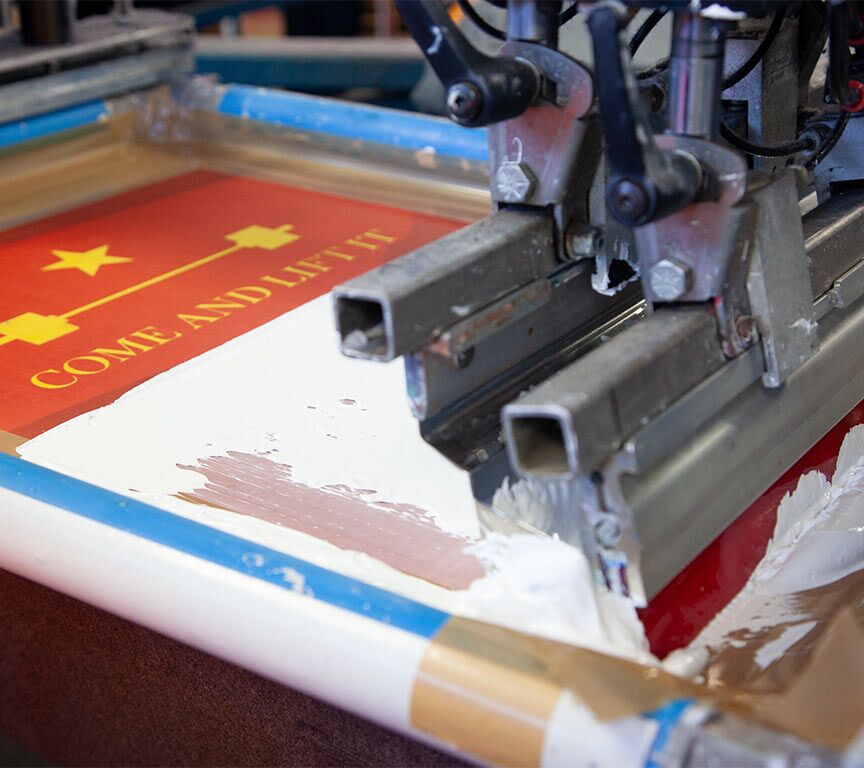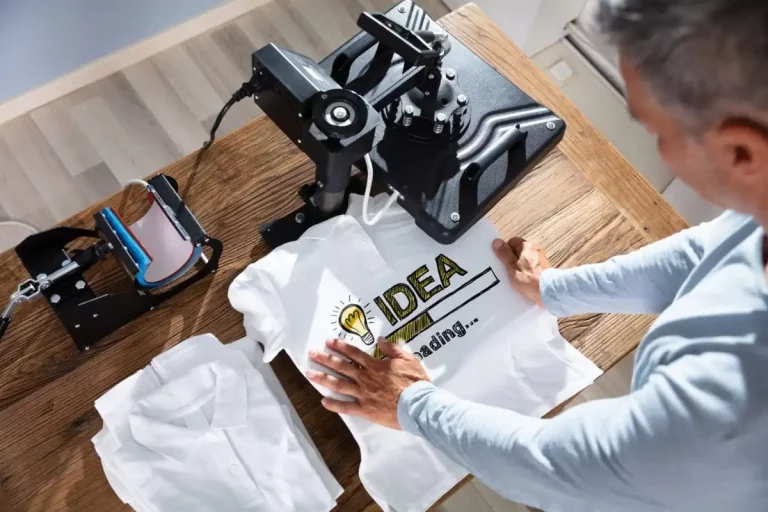Vintage Style Silk Screen Printing for Retro Fashion
Vintage Style Silk Screen Printing for Retro Fashion
Blog Article
Screen Printing Uncovered: Every Little Thing You Need to Understand About T-Shirt and Garment Printing Techniques
If you have actually ever before asked yourself how those lively layouts wind up on your preferred t-shirts, you're in the appropriate place. Display printing is a fascinating technique that combines art with strategy, offering unlimited opportunities for imagination. Understanding the basics, from equipment to ink options, can significantly affect your outcomes. All set to discover the essential components that make display publishing an art type? Allow's uncover the details that can boost your projects.
The Fundamentals of Display Printing: How It Functions
When you plunge right into screen printing, you'll discover it's both an art and a science. At its core, display printing includes developing a pattern, or display, that allows ink to pass with only in particular areas.
Placement the screen over the material, then utilize a squeegee to push ink with the display onto the garment. Each step is necessary, and mastering them will boost your screen printing skills, transforming easy garments right into distinct, meaningful items.
Sorts Of Display Printing Methods
As soon as you grasp the basics of screen printing, it's time to discover the various strategies that can boost your layouts. One preferred method is typical display printing, where ink is pushed with a stenciled display. This technique is excellent for strong, lively colors. There's water-based ink printing, which uses a softer feel and is environmentally friendly, yet it needs a various method to curing.
If you're going for great details, consider discharge printing. This technique removes dye from the fabric, leaving a soft, vintage appearance. One more choice is plastisol printing, known for its toughness and brilliant shades, making it a favored for lots of brand names. Lastly, experiment with halftone printing to produce slope effects and detailed layouts. Each method has its special beauty, so don't be reluctant to attempt them out to find what matches your style best!
Necessary Tools for Display Printing
To achieve spectacular results in screen printing, having the best tools is basic. You'll require a strong screen printing frame, which holds the mesh that transfers your design onto the garment. Next, buy premium squeegees; these are vital for using ink uniformly throughout the display. You'll also require a good direct exposure device to develop your screens, along with a washout cubicle for cleansing them after use. A trusted warmth resource, like a conveyor dryer or warm press, is crucial for healing your prints to assure long life. Do not forget a correct workspace, equipped with tables and storage for your supplies. Protective gear, such as masks and gloves, will certainly maintain you secure from chemicals and inks. With the right devices, you'll be well on your method to generating professional-quality prints.
Picking the Right Inks and Materials
When choosing inks and products for display printing, you need to consider the type of ink that functions best for your task. Think about textile compatibility to assure your layouts look last and great lengthy. Additionally, check out environmentally friendly ink options to make your printing process extra lasting.
Kinds Of Screen Inks
Selecting the right display ink is necessary for attaining dynamic, long lasting prints that meet your project's requirements. There are several kinds of display inks to take a look at. Specialty inks, such as metallic or glow-in-the-dark, can add distinct results to your layouts.

Fabric Compatibility Considerations
Understanding fabric compatibility is vital for accomplishing top quality screen prints, especially given that different products respond uniquely to various inks. Always check your inks on sample fabric to guarantee they adhere effectively and keep color stability. Additionally, keep in mind that material weight and appearance can impact the final result, so selecting the ideal ink and product combo is essential for your project's success.
Eco-Friendly Ink Options
Eco-friendly inks are coming to be a preferred choice for display printers that intend to reduce their ecological impact while maintaining high quality. When choosing inks, consider water-based inks, which are much less harmful and simpler to cleanse up compared to typical solvents. These inks bond well with textiles, providing dynamic outcomes without poisonous chemicals. You could likewise explore eco-solvent inks that utilize fewer unpredictable natural compounds (VOCs), making them a much safer choice for both your wellness and the world.
In addition, seek inks made from renewable energies, such as soy or vegetable-based options. By selecting the ideal inks and materials, you'll not only produce magnificent styles but also add to an extra lasting printing procedure. Make the button, and your prints will show your commitment to the environment!
Preparing Your Layout for Display Printing

Submit Format Demands
To guarantee your design looks sharp and dynamic on fabric, you'll require to pay close interest to submit format needs for screen printing. Start with vector files like AI or EPS, as they can be scaled without losing quality. If you use raster images, go with high-resolution documents, such as TIFF or PNG, ideally at 300 DPI. Stay clear of using JPEGs, as they can lose clarity when resized. Make sure your layout has a transparent background to stop undesirable white sides on your prints. Finally, keep color settings in mind; CMYK is basic for screen printing, so convert your RGB makes accordingly. By complying with these standards, you'll set your artwork up for an effective print.
Shade Splitting Up Methods
Shade separation is a necessary action in preparing your design for display printing, and grasping it can considerably improve your print high quality. You'll require to damage your style into specific colors, as each shade calls for a separate screen during printing. This precision not just ensures precise shade representation but likewise enhances the printing procedure.
Resolution and Size
Attaining the most effective lead to display printing starts with assuring your style has the right resolution and dimension. Preferably, your artwork ought to be at least 300 DPI (dots per inch) for sharp, clear prints. If you utilize reduced resolution, your end product could look less than professional and pixelated.
When it pertains to size, take into consideration the dimensions of your print area. Design your artwork to match the last print dimension, preferably developing it in the real dimensions you'll be publishing. In this manner, you'll stay clear of any kind of unexpected scaling problems.
Constantly inspect your design in both vector and raster styles. Vector graphics can be scaled without shedding high quality, making them perfect for screen printing. Preparing properly will ensure your layout looks fantastic on every garment!
Step-by-Step Screen Printing Refine
Screen printing is a vibrant process that allows you to develop dynamic layouts on various surfaces. To obtain started, you'll need a screen, emulsion, and your selected ink.
After rinsing the unexposed emulsion, your screen prepares. Establish it up on your printing surface and align your garment below it. Pour ink onto the screen and use a squeegee to push the ink through the pattern onto the textile. Lift the screen thoroughly and allow the print dry. Finally, treat the ink utilizing heat to guarantee longevity. That's it! You've efficiently display published your layout.
Tips for Effective Screen Printing Projects
While you're diving right into your screen printing jobs, bear in mind that preparation is vital to success. Begin by collecting all your materials-- inks, displays, garments, and squeegees. A clean work area helps avoid undesirable errors, so clean up prior to you start.
Following, verify your art work is high-resolution and effectively sized for your garment. Examine your screen for proper direct exposure and clean it thoroughly to prevent spots. When mixing your inks, comply with the manufacturer's guidelines to attain the right uniformity.
During printing, apply even stress with your squeegee for regular outcomes. Don't hurry; take your time to confirm each print fulfills your criteria. After printing, let your garments dry totally prior to taking care of or packaging them.
Lastly, always maintain an example of your work for future referral. In this manner, you can analyze your progression and improve your strategies in time. Delighted printing!

Often Asked Inquiries
The length of time Does It Require To Establish up a Screen Printing Work?
Setting pop over to this web-site up a display printing task typically takes around 30 mins to an hour. You'll prepare the displays, mix inks, and adjust the you could try this out press. The time differs based upon intricacy and experience, so stay organized!
Can I Print on Various Textile Keys In Using the Very Same Technique?
Yes, you can print on different textile kinds using the same technique, but you'll require to change your setups and inks. Some fabrics absorb ink differently, so trying out assurances the finest outcomes for each and every product.
What Are Typical Errors to Avoid in Display Printing?
When screen printing, prevent usual mistakes like using the wrong ink, ignoring proper direct exposure times, or missing pre-press checks. Constantly evaluate your setup and maintain clean displays to ensure top quality results each time.
How Can I Effectively Tidy and Preserve My Display Printing Tools?
To effectively clean and maintain your screen printing devices, you must regularly clean screens with ideal solvents, examine mops for wear, and assure all devices are kept dust-free and completely dry. Uniformity stops expensive repair services and boosts efficiency.
Is Display Printing Eco-friendly Contrasted to Various Other Methods?
Display printing can be extra eco-friendly than various other approaches, specifically if you make use of water-based inks and eco-conscious products. By selecting lasting supplies and techniques, you lower waste and lessen your effect on the earth.
Display Printing Uncovered: Every Little Thing You Required to Know Regarding Tee Shirt and Garment Printing Techniques
At its core, display printing involves creating a stencil, or screen, that permits ink to pass through just in particular areas. Setting the display over the fabric, after that make use of a squeegee to push ink with more helpful hints the display onto the garment. One preferred approach is conventional screen printing, where ink is pressed via a stenciled display.When picking inks and products for display printing, you require to take into account the type of ink that works finest for your project.
Report this page